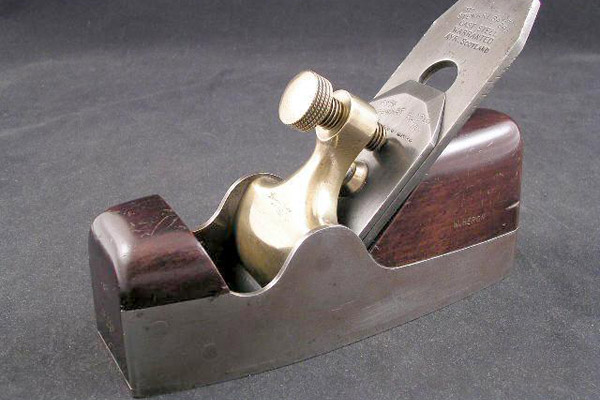
In the world of infill planes, there is no more prolific maker than Stewart Spiers. Planes made by the firm can be found in all corners of the globe, as it was in business from 1840 to around the mid 1940’s — some 100 or so years of infill plane manufacturing. No wonder there are so many of them out there!
This particular example is a late model infill plane by the company. The reason is unsure as to why the model numbers changed throughout the years, as this plane is no different than that of the No.6 model illustrated in the 1909 or the 1930’s catalogues. In fact the numbering is so confusing that several different styles have been observed with No.27 stamped on them, including open-handled parallel smoothing planes, 13-1/2″ panel planes and the unhandled coffin, or round sided, smoothing planes such as this one.
This No.27, however, is 7-1/2″ in length and 2-1/2″ wide. The gunmetal lever cap is stamped with the “STEWART SPIERS, REGD” script mark and the toe is stamped “SPIERS AYR, 27” on the Brazilian rosewood infill and “DOVETAILED” on the front edge of the steel sole.
The original 2-1/8″ wide parallel cutting iron, the backing iron and the bed are all stamped “1”, denoting the factory assembly numbers.
Originally apprenticed as a cabinetmaker in his father’s business, a young Stewart Spiers chanced upon a rough casting of a plane on a trip away from his home town of Ayr in Scotland. That casting was to change Stewart’s life, and he went on to design some of the most iconic styles and patterns of hand planes that we know today.
With so many planes being manufactured and sold it soon became apparent that the company would need more workers building them, and it is known that at least three were employed at the factory by the early 1850’s. The factory wasn’t a large one however, so not too many more men would have been working for Spiers at any time.
Stewart Spiers died in 1899, and the firm was then taken over by his two daughters. Later the company was sold to John McFadyen, who had become the foreman of the factory just after Stewart’s death. By the early 1930’s a Mr. T.R. Lamont had become proprietor and the business moved to the Paisley address.













